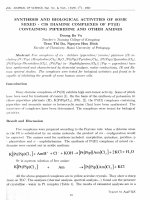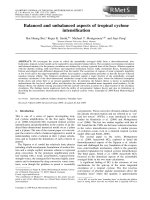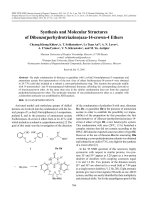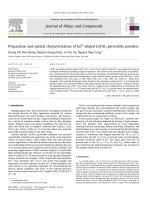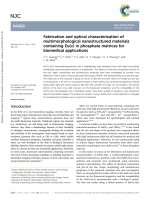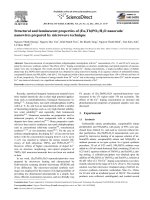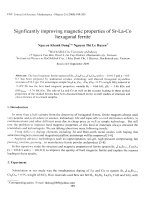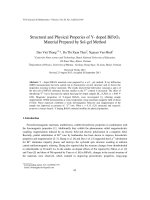DSpace at VNU: Structural and Optical Properties of Samarium Doped Calcium Fluoride Nanoparticles Synthesized By Co-Precipitation Technique
Bạn đang xem bản rút gọn của tài liệu. Xem và tải ngay bản đầy đủ của tài liệu tại đây (2.59 MB, 9 trang )
VNU Journal of Science: Mathematics – Physics, Vol. 32, No. 1 (2016) 44-51
Structural and Optical Properties of Samarium Doped Calcium
Fluoride Nanoparticles Synthesized
By Co-Precipitation Technique
Duong Thi Mai Huong*, Le Van Vu, Nguyen Ngoc Long, Duong Ngoc Thanh
Center for Materials Science, Faculty of Physics, VNU University of Science,
334 Nguyen Trai, Thanh Xuan, Hanoi, Vietnam
Received 23 February 2016
Revised 15 March 2016; Accepted 18 March 2016
Abstract: CaF2 nanoparticles doped with 0, 1, 2, 3, 4 and 5 mol% Sm3+ were prepared by coprecipitation method. These nanoparticles were studied by X-ray diffraction (XRD), transmission
electron microscopy (TEM), photoluminescence (PL), photoluminescence excitation (PLE)
spectra, energy-dispersive X-ray spectroscopy (EDS) and diffuse reflective spectra. The XRD
patterns indicate cubic structure of CaF2 and no other impurities. TEM images show that CaF2
nanoparticles have size varying from 15 to 20 nm. The photoluminescence spectra show 4 peaks at
566 nm, 604 nm, 645 nm and 704 nm, which are assigned to different transitions from the 4G(4)5/2
excited state to the 6HJ with J = 5/2; 7/2; 9/2 and 11/2 ground states of Sm3+ ions. The PLE spectra
show 8 lines, which are attributed to the absorption transitions from the 6H5/2 ground state to the
4
H(1)9/2, 4D(2)3/2, 6P7/2, 4F(3)7/2, 6P5/2, 4M17/2, 4I(3)13/2 and 4M15/2 excited states. Six lines among eight
excitation lines were observed in the diffuse reflection spectra.
Keywords: CaF2 nanoparticles, samarium, co-precipitation technique.
1. Introduction∗
Fluoride materials are attractive materials with potential applications such as dental [1-3],
photonics, image display, light amplification and precursors for ceramic processing . Among the alkali
fluorides, calcium fluoride (CaF2) is an attractive material for high stability and non-hygroscopic
properties. CaF2 is an ideal host material for emitting ions in a wide wavelength range, with low
refractive index and low phonon energy.
With the development of nanotechnology, many techniques have been developed to synthesize
CaF2 nanostructures such as precipitation [4-8], hydrothermal [9,5,6], sprayring [2,3], plasma
synthesis in vacuum [1], micro-emulsions [10].
_______
∗
Corresponding author. Tel.: 84-988648823
Email:
44
D.T.M. Huong et al. / VNU Journal of Science: Mathematics – Physics, Vol. 32, No. 1 (2016) 44-51
45
It is well-known that rare-earth (RE) ions have sharp absorption and emission bands from the UV
to infrared range. For that reason, RE doped materials possess potential applications in many different
fields such as optoelectronics, photonics and biomedicine . However, to the best of our knowledge,
most of previous works have been focused on CaF2 doped with Dy3+ [11], Tm3+[11], Sm3+ [12], Er3+
[10], Eu3+ [13], Eu2+[9,14], etc... CaF2 was also co-doped with Mn2+ and Eu2 + [13], Yb3+ and Er3+ [15],
etc … Ca2+ in the lattice can be replaced by rare earth (RE) ions. According to our knowledge, only a
few works were devoted to CaF2 doped with Sm3+ ions [16]. Ion radius of Sm3+ is 0.958 Å which is
nearly equal to the radius of Ca2+ ion (1.000 Å). Therefore, it is expected that the Sm3+ ion can easily
substitute for Ca2+ ion in the host crystal.
In this report, we fabricated CaF2:Sm3+ nanoparticles by co-precipitation method. The structure,
absorption, PL and PLE properties of the samples were investigated in detail.
2. Experimental
Undoped and Sm3+-doped CaF2 nanoparticles were prepared by coprecipitation method from
solutions of calcium chloride CaCl2, samarium nitrate Sm(NO3)3 and NH4F. An appropriate amount of
NH4F was dissolved in double distilled water under constant stirring for 10 min to form NH4F
solution. To prepare Sm3+-doped samples, stoichiometric amounts of CaCl2 and Sm(NO3)3 aqueous
solutions were mixed together. The molar ratio of Sm:Ca was equal to 0; 1; 2; 3; 4 and 5 mol%.
In the next step, appropriate amounts of NH4F solution were added into the mixed nitrate solution
under stirring for 3h at room temperature. After that, the resulting precipitate was filtered off and
washed several times in water and ethanol to remove the chemicals remaining in the final products.
The products were dried in air at 65 oC for 5 h.
Crystal structure of the obtained powders was analyzed by X-ray diffraction (XRD) using an X-ray
diffractometer SIEMENS D5005, Bruker with Cu Kα1 (λ = 1.54056 Å) irradiation. Surface
morphology of the samples was observed by using a Nova nano SEM 450. Composition of the
samples was determined by an energy-dispersive X- ray spectrometer (EDS) OXFORD ISIS 300.
Room temperature PL and PLE spectra were collected on a spectrofluorometer Fluorolog FL 3-22
Jobin-Yvon-Spex with a 450 W Xenon lamp as excitation source. Diffuse reflection measurements
were carried out on a UV-VIS-NIR Cary-5000 spectrophotometer. The spectra were recorded in the
wavelength region of 300-600 nm. Absorption spectra of the samples were obtained from the diffuse
reflectance data by using the Kubelka-Munk function [2]:
(1 − R )2 K
=
2R
S
where R, K and S are the reflection, the absorption and the scattering coefficients, respectively.
F ( R) =
3. Results and Discussions
3.1 Structure characterization and morphology
Typical XRD patterns of CaF2 nanoparticles doped with 0; 1; 2; 3; 4 and 5 mol% Sm3+are
presented in Fig.1. In all case, the powder XRD analysis evidenced that the obtained CaF2 samples
have simple cubic crystal structure. No diffraction peak of other substances are detected. It is noted
46
D.T.M. Huong et al. / VNU Journal of Science: Mathematics – Physics, Vol. 32, No. 1 (2016) 44-51
that the introduction of different RE ion concentration does not change the crystal structure of the
products.
60
a - C aF 2 :0% Sm
3+
b - C aF 2 :2% Sm
c - CaF 2 :1% Sm
3+
d - CaF 2 :3% Sm
3+
e - CaF 2 :4% Sm
3+
f - CaF 2 :5% Sm
3+
3+
(220)
Intensity (a.u.)
(111)
40
(311)
(400)
f
e
20
d
c
b
a
0
10
20
30
40
50
60
70
2 theta (degree)
Fig.1. Typical XRD patterns of the undoped and Sm3+-doped CaF2 nanopowders with different concentration.
The lattice constants of the CaF2 nanocrystals determined from the XRD patterns are a = 5.459 ±
0.001 Å, which are in good agreement with the standard values a = 5.463 Å (JCPDS 4-864). The
0.9λ
average size of the nanocrystals was estimated by using Debye-Scherrer’s formula [13]: D =
β cos θ
where β is the full width at half maximum (FWHM) in radians of the diffraction peaks, θ is the
Bragg’s diffraction angle and λ = 0.154056 nm. The estimated size of the CaF2 nanocrystals was D =
13 ± 1 nm.
TEM images of the undoped samples are illustrated in Fig. 2. As can be seen from the image, the
CaF2 samples are composed of nanoparticles. The particle diameter ranges from 15 to 20 nm, which
are slightly bigger than that calculated by Debye-Scherrer’s formula. It is also noted that the
nanoparticles agglomerated into big clusters.
Fig. 2. TEM image of the undoped CaF2 nanoparticles.
D.T.M. Huong et al. / VNU Journal of Science: Mathematics – Physics, Vol. 32, No. 1 (2016) 44-51
Ca
CaF2:0mol% Sm
3+
CaF2:5mol% Sm
3+
47
F
Intensity (a.u.)
C
Sm
Ca
Sm
Sm Sm
Ca
F
Ca
C
0
2
4
6
Energy (KeV)
8
10
Figure 3. EDS spectra of undoped CaF2 nanoparticles and CaF2 nanoparticles doped with 5 mol% Sm3+.
The EDS spectra of the undoped (a) and 5 mol% Sm3+-doped (b) CaF2 nanoparticles are shown in
Fig. 3. The undoped sample mainly consisted of canxi (Ca), fluor (F) elements, whereas in the
CaF2:5%Sm3+ sample Sm element appeared, indicating the incorporation of Sm3+ ions into the host
lattice. It is noted that peak related to carbon (C) comes from the carbon tapes used for EDS
measurement.
3.2. Photoluminescence and absorption properties
Fig.4 shows the room temperature PLE spectrum monitored at 604 nm emission line and the PL
spectrum under excitation wavelength of 400 nm of the CaF2 nanoparticles doped with 2 mol%Sm3+.
As will be seen in Fig.4, the lines in the spectra are interpreted as the absorptive and radiative intraconfigurational f-f transitions within the Sm3+ ions.
100
PL
PLE
λem= 400nm
λexc= 604nm
80
CaF2:1mol%Sm
400
604
60
360
40
20
371
415
443
PL intensity (a.u.)
566
3+
342
463
480
645
0
350
400
450
500
550
600
650
704
700
750
Wavelength (nm)
Fig. 4.PL (with λexc = 400 nm) and PLE (at λem = 604 nm) spectra of the CaF2:1 mol% Sm3+ sample.
48
D.T.M. Huong et al. / VNU Journal of Science: Mathematics – Physics, Vol. 32, No. 1 (2016) 44-51
100
604
566
3+ a: 0mol%
CaF2: Sm
b: 1mol%
λem= 400 nm
c: 2mol%
d: 3mol%
e: 4mol%
f: 5mol%
PL intensity (a.u.)
80
60
645
40
704
b
20
a
f
0
500
550
600
650
Wavelengh (nm)
700
750
Fig.5. The PL spectra of the CaF2:Sm3+nanopowders doped with different dopant concentrations under
400 nm excitation wavelength.
The room temperature PL spectra of CaF2 nanoparticles undoped and doped with 1;2;3; 4 and 5
mol%Sm3+ excited by 400 nm wavelength are illustrated in Fig. 5. The undoped CaF2 nanoparticles do
not exhibit the groups of emission lines in the wavelength range from 550 to 750 nm, whereas the
Sm3+-doped CaF2 nanoparticles show a group of four emission lines at 566, 590, 604, and 640 nm. Fig.
5 indicates that the PL intensity related to Sm3+ ion reaches maximum value when the dopant content
is 1 mol%.
4
80
G(4)5/2
H5/2
566
PL intensity (a.u.)
CaF2:1mol%Sm
6
6
3+
λem= 400 nm
H7/2
604
60
40
20
6
H9/2
645
0
500
550
600
650
6
H11/2
704
700
750
Wavelength (nm)
Fig.6. The room temperature PL spectrum of CaF2:1%Sm3+sample excited by 400 nm wavelength and
corresponding transitions.
Fig. 6 depicted typical PL spectrum excited by 400 nm wavelength of 1 mol% Sm3+-doped CaF2
nanoparticles.The group of emission lines at 566, 590,604, and 640 nm are assigned to the transitions
D.T.M. Huong et al. / VNU Journal of Science: Mathematics – Physics, Vol. 32, No. 1 (2016) 44-51
49
from the excited state 4G(4)5/2to the ground states 6HJ with J = 5/2;7/2; and 9/2 of Sm3+ ion,
respectively.
6
H5/2
400
CaF2:1 mol% Sm
4
40
P5/2
6
D(2)3/2
6
415
373
4
I(3)13/2
M17/2
4
M15/2
463
480
344
0
λem= 600 nm
4
362
20
3+
4
H(1)9/2
60
P7/2
F(3)7/2
4
PLE intensity (a.u.)
80
443
350
400
450
500
Wavelengh (nm)
Fig. 7. The PLE spectrum of CaF2:1mol%Sm3+sample monitored at emission wavelength of 604 nm and
corresponding transitions.
It is worth noting that all the mentioned above emission lines have the same excitation spectra,
which demonstrates that all these lines possess the same origin. Typical PLE spectrum monitored at
604 nm emission line of 1mol% Sm3+-doped CaF2 nanoparticles is illustrated in figure 7. The
excitation lines located at 345, 361, 372, 400, 413, 443,and 468 nm are attributed to the absorption
transitions from the 6H5/2 ground state to the 4H(1)9/2, 4D(2)3/2, 6P7/2, 4F(3)7/2, 6P5/2, 4M17/2, and 4I(3)13/2
excited states, respectively. Fig. 8 depicts diffuse reflection spectra measured at room temperature of
the undoped CaF2 and the 1, 2, 3, 4, 5 mol% Sm3+-doped CaF2 nanoparticles. It can be seen that there
is no absorption line in the diffuse reflection spectrum of the undoped CaF2 nanoparticles, while eight
weak absorption lines at 361, 373, 400, 415, 440, 462, 477 and 560 nm are clearly observed in the
spectra of Sm3+doped CaF2 nanoparticles.
85
a
b
c
80
d
75
e
60
55
400
50
350
400
440
560
a - 0% Sm
b - 1% Sm
c - 3% Sm
d - 4% Sm
e - 5% Sm
462
477
65
415
70
361
373
Reflectance (%)
90
450
500
550
600
650
700
750
Wavelength (nm)
Fig. 8. Diffuse reflectance spectra of the CaF2:Sm3+ samples with different dopant concentrations.
D.T.M. Huong et al. / VNU Journal of Science: Mathematics – Physics, Vol. 32, No. 1 (2016) 44-51
CaF2
400
2.8
a - 0% Sm
b - 1% Sm
c - 3% Sm
d - 4% Sm
e - 5% Sm
2.4
2.0
462
1.2
477
415
1.6
361
373
K-M function F(R) (a.u.)
3.2
440
50
560
0.8
e
d
c
b
a
0.4
0.0
400
500
600
700
Wavelength (nm)
Fig. 9. Kulbelka-Munk function graph of Sm3+-doped CaF2samples.
Absorption spectra obtained from the diffuse reflectance data by using the Kubelka–Munk
function F(R) for the undoped CaF2 and the 0÷5 mol% Sm3+-doped CaF2 nanoparticles are shown in
figure 9. It is interesting to note that all the mentioned above absorption lines observed in the plot of
Kubelka-Munk function have appeared in the excitation spectra as shown in figure 7. The absorption
lines located at 361, 373, 400,415, 440, 462, 477 and 560 nm are assigned to the optical transitions
from the 6H5/2 ground state to the 4D(2)3/2, 6P7/2, 4F(3)7/2, 6P5/2, 4I(3)13/2,4M15/2, and 4G5/2 excited states,
respectively.
4. Conclusion
Sm3+doped CaF2 nanoparticles were prepared by co-prcipitation method. The XRD analysis
showed that the nanoparticles have a pure cubic structure. The fluorescent measurements indicate that
PL intensity is strongest in the CaF2 samples doped with 1mol% Sm3+. The PL and PLE spectra of
Sm3+ ions result from the optical intra-configurational f–f transitions. Some excitation lines were
observed as well in diffuse reflection spectra measured at room temperature.
Acknowledgments
The authors would like to thank Hanoi University of Science for financially supporting this
research through Project No TN 15-06. The authors thank the VNU project" Strengthening research
and training capacity in fields of Nano Science and Technology, and Applications in Medical,
Pharmaceutical, Food, Biology, Environmental protection and climate change adaptation in the
direction of sustainable development" for providing the equipment to complete this work.
D.T.M. Huong et al. / VNU Journal of Science: Mathematics – Physics, Vol. 32, No. 1 (2016) 44-51
51
References
[1] N. Emre Cetin,Sadan Korkmaz, Saliha Elmas, Naci Ekem, Suat Pat, M. Zafer Balbag, Enver Tarhan, Sinan
Temel and Murat Ozmumcu, “The structural, optical and morphological properties of CaF2thin films by using
Thermionic Vacuum Arc (TVA)”, Materials Letters 91 (2013) 175-178.
[2] LeiCheng,Michael D. Weira,Hockin H.K. Xu, Alison M.Kraigsley,Nancy J.Lin,ShengLin -Gibson and Xuedong
Zhou, “Antibacterial and physical properties of calcium–phosphate and calcium–fluoride nanocomposites with
chlorhexidine”, Dental Materials 28 (2012) 573–583.
[3] Limin Sun and Laurence C. Chow, “Preparation and properties of nano-sized calcium fluoride for dental
applications”, Dental Materials 24 (2008) 111–116.
[4] Sohan M. Chauhan and B. S. Chakrabarty, “Lead (Pb) doped fluoride nanocrystals: Structural and Optical
Properties”, International Journal of Advanced Research2 (2014) 607-614.
[5] Feng Wang, Xianping Fan, Daibo Pi and Minquan Wang, “Synthesis and luminescence behavior of Eu3+-doped
CaF2 nanoparticles”, Solid State Communications 133 (2005) 775-779.
[6] P.N. Zhmunrin, O.Yu Sythik, O.V. Svidlo, V.N. Lebedev and A.F. Adadurou, “Synthesis and luminescent
properties of CaF2: Eu2+ nanocrytals”, Functional Material 19 (2012) 272-275.
[7] K. Tahvildari, M. Esmaeili pour, Sh. Ghammamy and H. Nabipour, “CaF2nanoparticles: Synthesis and
characterization”, International Journal of Nano Dimension 2 (2012) 269-273.
[8] Nakhaei Omolfajr, Shahtahmassebi Nasser, Rezaeeroknabadi Mahmood and Ahmad Kompany , “Synthesis and
Characterization of CaF2 NPs with Co-precipitation and Hydrothermal Method”, Journal of Nanomedicine &
Nanotechnology 2 (2011) 1000116 (12 pages).
[9] C. Pandurangappa, B.N. Lakshminarasappa and B.M. Nagabhushana, “Synthesis and characterization of CaF2
nanocrystals”, Journal of Alloys and Compounds 489 (2010) 592–595.
[10] Jinghong Song, Guanglin Zhi, Yan Zhang and Bingchu Mei, “Synthesis and Characterization of CaF2
Nanoparticles with Different Doping Concentrations of Er3+”, Nano-Micro Letters 3 (2011) 73-78
[11] G. Lakshminarayana, Rong Yang, Mengfei Mao, Jianrong Qiu and I.V. Kityk, “Photoluminescence of Sm3+, Dy3+
and Tm3+-doped transparent glass ceramics containing CaF2 nanocrystals”, Journal of Non-Crystalline Solids 355
(2009) 2668–2673
[12] C. Pandurangappa and B.N. Lakshminarasappa, “Luminescence studies in Gamma rayed Sm doped
nanocrystalline CaF2”, Inernational Journal of Science Research 1 N4229-231.
[13] U Caldino G, “Energy transfer in CaF2 doped with Ce3+, Eu2+ and Mn2+ ions”, J. Phys: Condens. Matter.15 (2003)
7127–7137.
[14] P.N. Zhmurin, O.Yu. Sythik, O.V. Svidlo, V.N. Lebedev and A.F. Adadurov, “Synthesis and luminescent
properties of CaF2:Eu2+ nanoscrystals”, Functional Materials 19 (2012) 273-275.
[15] Liu Zhengyi, Synthesis and Characterization of CaF2:Yb,Er (Core)/CaF2 (Shell) up-conversion nanoparticles,
National University of Singapore, (2010).
[16] R.D. Shannon, Revised effective ionic radii and systematic studies of interatomic distances in halides and
chalcogenides, Acta Cryst. A32 (1976) 751-767.
52
D.T.M. Huong et al. / VNU Journal of Science: Mathematics – Physics, Vol. 32, No. 1 (2016) 44-51

